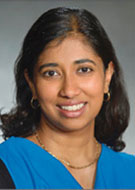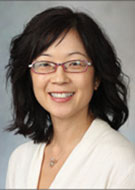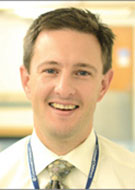The Path to Patient-Centered Radiology
Breast density clinics and patient-friendly imaging reports are among unique initiatives



While patient care has always been at the center of radiology, the shift from quantity to quality in the reading room has provided new opportunities to expand the role of radiologists while meeting the needs of 21st century patients.
Today’s patients are strong self advocates who will search the web for information to better understand their medical situation. And while some radiology subspecialties have always had direct patient contact, others are moving toward a more patient-centered experience.
Many radiology departments have developed unique customer-focused initiatives that address the needs of their specific patient population, including co-location of radiologists with clinical teams and patient-friendly radiology reports.
Embedding Radiologists in Clinical Care Areas
The Mayo Clinic Model of Care is a long-established set of principles that the institution has been following since its founding. It calls for high-quality, compassionate medical care delivered in a multispecialty, integrated practice and has been embraced by the Department of Radiology, according to Amy K. Hara, MD, department chair at the Mayo Clinic in Phoenix.
“In the Mayo Clinic Model of Care, the needs of the patient always come first and it’s a way of working that is part of our culture,” Dr. Hara said. “Patient-centered care involves an integrated, multi-specialty model where the radiologists are embedded in clinical areas to address patient needs alongside our fellow physicians. Therefore, the breast imagers are embedded with the breast surgeons to facilitate discussions around a patient’s treatment or emergent care.”
This focus on patient care has led the department to continually seek better ways to address patients’ needs.
For example, the department offers extended imaging hours. More recently, with the new U.S. Food and Drug Administration (FDA) requirement of dense breast reporting to patients, Mayo Clinic has opened dense breast clinics, offering appointments for patients to speak directly with breast imagers.
“Once patient portals were established and patients could access their records, those with questions began pushing for answers about what they were seeing in their files,” Dr. Hara said. “Our dense breast clinic is just one of the ways that Mayo is working to connect patients with radiologists to address questions and help them understand medical terms in their records that might be confusing or frightening.”
In fact, figuring out how to write imaging reports using more layperson’s language is the next project the Mayo Clinic is considering, along with several other projects identified during recent patient focus groups.
“Our reports should provide clear information both for patients and clinicians. As our technology and interpretations continue to increase in complexity, we need to simultaneously consider strategies to optimize communication among these different groups,” Dr. Hara said.
Pediatric Radiology Is Family-Centered
At Cincinnati Children’s Hospital in Ohio, radiology has always been family-centered since helping a child through challenging imaging appointments is best done with the support of the child’s family.
“In pediatric radiology, we are focused on the family and understand the importance of sharing imaging results as soon as possible,” said Alexander Towbin, MD, associate chief, Operations and Informatics, the Neil D. Johnson Chair of Radiology Informatics and an associate professor of radiology at Cincinnati Children’s Hospital. “We have a program to deliver immediate results to our families. We know that waiting for the results of any imaging study can be stressful. Our radiologists work hard to make ourselves accessible to families.”
The radiology department also has a process to deliver difficult news to families. Radiologists relay this information in conjunction with the referring physician and also schedule additional imaging studies and connect families with oncologists or other specialists, if needed.
“Radiologists know the next steps and the next type of imaging needed for specific diagnoses, so it makes sense that we would shepherd families through to the next part of their medical treatment,” Dr. Towbin said.
Radiologists also communicate with patients indirectly through an EHR portal. However, Dr. Towbin acknowledges that creating an imaging report with language that patients can understand is an ongoing challenge.
“There is room to do better in creating reports that are patient-friendly and that direct them to reputable sources of information on the internet to learn more about the exam or their diagnosis,” Dr. Towbin said. “The challenge is that some medical terms aren’t easily translated to layperson’s language and there are some types of specialty language that will give specific direction to the referring doctor or to the surgeon. Creating a report that balances the patient’s need to understand with providing enough information for other physicians is still a work in progress.”

Identifying Novel Approaches to Meet Patient Needs
The Department of Radiology at the Perelman School of Medicine at the University of Pennsylvania in Philadelphia, recently established the Center for Practice Transformation (CPX), which facilitates the development, testing and implementation of initiatives to re-imagine care delivery to patients in radiology, improve patient outcomes, optimize patient and clinician experience and decrease the cost of care.
“Per the Center for Practice Transformation’s goals, we hope to apply innovation principles to identify opportunities that will improve how patients and their families experience radiology care,” said Tessa Cook, MD, PhD, co-director of the CPX and assistant professor of radiology at the University of Pennsylvania. “We’re hoping to usher radiology into the future, both within Penn Medicine and in the community at large by using cutting-edge technology to deliver care now and training the next generation of radiologists to deliver quality care in the future.”
In May, the CPX hosted an innovation challenge looking for creative ideas for improving the delivery of radiology services that could be successfully piloted in six months. While suggestions are still being evaluated, Dr. Cook is excited about the opportunities that they offer.
Prior to the establishment of the CPX, the university’s Department of Radiology staff had worked in teams to implement initiatives that optimized the patient experience, including redesigning the outpatient imaging area and launching an effort to decrease gadolinium exposure to patients with multiple sclerosis undergoing follow-up MRIs.
The CPX will also be looking at how to transform the detailed radiology report into a layperson’s report that is accessible through a patient’s electronic health record.
“The patient’s reading of a radiology report can be challenged by a lack of understanding and/or access to discuss the reports face-to-face with radiologists,” Dr. Cook said. “Patients’ access to images and reports and their understanding of those reports is an ongoing development.”
Creating a Customer-Focused Department
Departments looking to become more patient-centered should gather input from everyone in the radiology department, Dr. Cook recommended.
“Physicians, administrators, technologists, staff and nurses should all contribute to making a department more patient-centered,” she said. “Most important of all, patients should be part of the discussion because, after all, it is their experience that we’re trying to improve.”
Dr. Towbin agrees that patients need to be part of the improvement process.
“Our hospital has a patient council where we invite patients and their families to participate and identify what is important to them during imaging appointments or to figure out what the sticking points were during the process,” he said. “Without their feedback, we wouldn’t know where to focus our energies and with their help, we can implement some easy wins that will make their experience much better.”
RSNA Aids in Patient-Centered Training for Trainees
RSNA has developed the Patient-Centered Care Interactive Learning Set, an interactive curriculum of 13 customized learning modules intended to educate radiology trainees about the importance of patient-centered care. The resource, based on ACGME mandates, also provides trainees with methods and tools to aid in providing patient-centered care.
The curriculum is designed to be reviewed in small groups with a set of introductory tasks and some activities best accomplished through role play.
To access the free learning set, go to RSNA.org/Education.